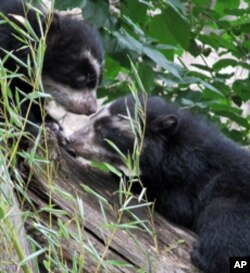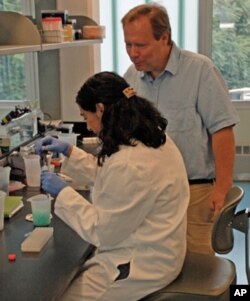For more than a century, the National Zoo in Washington has attracted visitors wanting to learn more about animals. Some 2,000 animals are currently in the collection, ranging from ants to elephants.
For half its history, exhibiting animals was its primary role, but the National Zoo has become a leader in wildlife conservation.
Resurrecting vanishing species
Visitors to the National Zoo can see animals representing nearly 400 species. About one fifth of them are considered threatened or endangered, like the Andean bear.
The media turned out in May for the formal introduction of two young cubs born this winter. They were the first to be born at the zoo in 22 years and the first to survive in North America since 2005.
"So we truly have a success story here, both for us and for conservation of species in its range country," says Dennis Kelly, director of the Smithsonian National Zoo.
Red pandas have been another success. There are fewer than 2,500 left in the wild, due to habitat loss in China, the Himalayas and Myanmar. The National Zoo has been responsible for the birth of more than 120 cubs.
Nurturing wildlife in the mountains of Virginia
Most were born about 100 kilometers from the zoo, at a 1,700-hectare campus nestled in the Shenandoah Mountains of Virginia, headquarters of the Smithsonian Conservation Biology Institute (SCBI).
"There are 225 zoos in the United States and only about five zoos have large off-site facilities like this one," says Steven Monfort, director of the SCBI. "What we try to do is have high profile species that are in need of science or breeding attention."
Between 30 and 40 species of mammals and birds are at the campus. Species like the Przewalski's horse, which originated on the steppes of Western Europe and Asia.
"We have 27 individuals here, the largest managed population in the United States," Monfort says. "That species was down to 12 purebred individuals after World War II. Now there are more than 1,500 in the world."
More than 400 have been reintroduced to China, Mongolia and Kazakhstan. Such successes lead to high expectations.
Monfort says zoos are too often asked to make miracles happen when a species is down to an incredibly small number of individual animals.
That was the case with the black-footed ferret, which is native to the American prairie. Twenty years ago, there were only 18 in the wild. "They were thought to be extinct and a small population was found," Monfort says.
Since then, more than 500 black-footed ferrets have been born at the National Zoo, many using artificial insemination and frozen sperm. Through reintroduction into the wild, the population has grown to 700.
Scientific advances aid progress
Advances in science have helped conservation in other ways. Scientists can now monitor hormones using fecal or urine samples. That helped researchers learn that when two female cheetahs are together, one can reproductively suppress the other.
DNA research also plays a role.
"They do population management designs for endangered and threatened species," says Rob Fleischer, head of the Center for Conservation and Evolutionary Genetics in the SCBI. "If the animals are in captivity, we try to mix them up more, try to make sure to design the breeding program so we don't lose genetic variability."
Although scientists at the zoo work with ancient DNA from animals that have been dead thousands of years or more, they won't be resurrecting any extinct animals any time soon, Monfort says.
"One of the things that bothers me the most about these high technology ideas of bringing back species from the dead is that the problems that we are facing today are so dramatic and species are declining so quickly that it is triage at best."
As it works to preserve vulnerable animals, the Smithsonian Conservation Biology Institute is also training the next generation of biologists to carry on their work. It has already trained over 4,000 professionals, as well as hundreds of graduate and post doctoral fellows from every continent.
"We need an army of people.," Monfort says, " The problems we are talking about aren't going to be solved in a single person's career." He says the challenges to wildlife - climate change, invasive species, and other human impacts on the environment - will continue.


